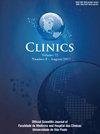The supramolecular polymer-related signature predicts prognosis and indicates immune microenvironment infiltration in gastric cancer
IF 2.4
4区 医学
Q2 MEDICINE, GENERAL & INTERNAL
引用次数: 0
Abstract
Background
Gastric Cancer (GC) remains a leading global cause of cancer mortality, underscoring the urgent need for advanced prognostic tools. This study aimed to construct and evaluate a prognostic risk signature based on Supramolecular Polymer-Related Genes (SPRGs) in gastric cancer.
Methods
The authors downloaded data from TCGA-STAD, GEO, and CCLE databases for patients with GC and validation cohorts. Through consensus clustering, Cox proportional hazards models, LASSO Cox regression, and nomogram development, the authors identified and constructed a GC Prognostic risk Index (SPI). Additionally, the authors conducted drug sensitivity analysis and immune landscape assessment. Functional evaluations were conducted through colony formation, transwell invasion, and wound healing assays.
Results
The authors identified that 182 SPRGs were significantly upregulated and 226 were downregulated in gastric cancer. Consensus clustering revealed two molecular subtypes, with cluster 1 having significantly lower overall survival compared to cluster 2. SPI effectively distinguished high-risk and low-risk patients across all cohorts. Furthermore, SPI was associated with tumor stage, lymph node metastasis, and tumor size, and could predict drug sensitivity in GC patients. Immune landscape analysis showed higher infiltration of naïve B cells, M2 macrophages, and activated NK cells in high-SPI patients. A nomogram model for GC prognosis using SPI and patient age was developed. KLC1 knockdown significantly suppressed GC cell proliferation, while markedly attenuating metastatic potential and invasion capacity.
Conclusion
This study constructed a prognostic risk signature based on SPRGs in gastric cancer, which is closely related to clinical pathological features, drug sensitivity, and immune landscape, providing new insights for personalized treatment.
超分子聚合物相关信号预测胃癌预后,提示免疫微环境浸润
背景胃癌(GC)仍然是全球癌症死亡的主要原因之一,因此迫切需要先进的预后工具。本研究旨在构建和评估基于超分子聚合物相关基因(SPRGs)的胃癌预后风险特征。方法作者从TCGA-STAD、GEO和CCLE数据库中下载了胃癌患者和验证队列的数据。通过共识聚类、Cox 比例危险模型、LASSO Cox 回归和提名图开发,作者确定并构建了胃癌预后风险指数(SPI)。此外,作者还进行了药物敏感性分析和免疫景观评估。结果作者发现胃癌中有 182 个 SPRGs 明显上调,226 个下调。共识聚类发现了两种分子亚型,聚类1的总生存率明显低于聚类2。在所有组群中,SPI能有效区分高风险和低风险患者。此外,SPI还与肿瘤分期、淋巴结转移和肿瘤大小有关,并能预测GC患者对药物的敏感性。免疫图谱分析显示,高SPI患者的幼稚B细胞、M2巨噬细胞和活化NK细胞浸润较高。利用SPI和患者年龄建立了一个GC预后提名图模型。结论 本研究构建了基于 SPRGs 的胃癌预后风险特征,它与临床病理特征、药物敏感性和免疫景观密切相关,为个性化治疗提供了新的见解。
本文章由计算机程序翻译,如有差异,请以英文原文为准。
求助全文
约1分钟内获得全文
求助全文
来源期刊

Clinics
医学-医学:内科
CiteScore
4.10
自引率
3.70%
发文量
129
审稿时长
52 days
期刊介绍:
CLINICS is an electronic journal that publishes peer-reviewed articles in continuous flow, of interest to clinicians and researchers in the medical sciences. CLINICS complies with the policies of funding agencies which request or require deposition of the published articles that they fund into publicly available databases. CLINICS supports the position of the International Committee of Medical Journal Editors (ICMJE) on trial registration.
 求助内容:
求助内容: 应助结果提醒方式:
应助结果提醒方式:


